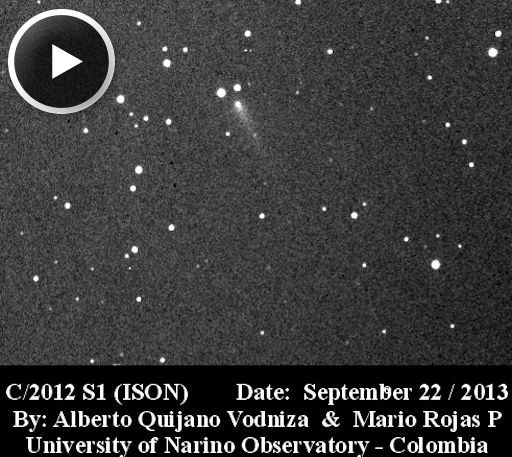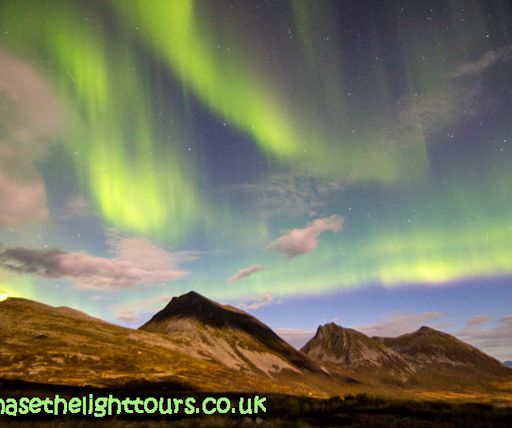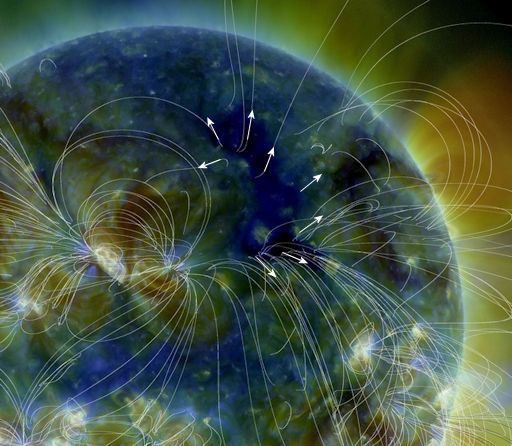Listen to radar echoes from satellites and meteors, live on listener-supported Space Weather Radio. | | |
SLIGHT CHANCE OF STORMS: NOAA forecasters estimate a 10% chance of polar geomagnetic storms on Sept. 23-24. That's when a minor CME could deliver a glancing blow to Earth's magnetic field. Arctic sky watchers should be alert for auroras. Aurora alerts: text, voice.
COMET ISON IN MOTION: Comet ISON is falling toward the sun for a close encounter on Thanksgiving Day 2013. If it survives, it could become one of the finest comets in years. At the moment ISON is still far away and faint, but its sunward velocity is impressive--more than 72,000 mph on Sept. 22nd. Click on the image to see the comet in motion:

Alberto Quijano Vodniza of Pasto, Narino, Colombia, obtained the 35-minute video on Sept 22nd. "The motion of the comet was clearly visible," he says. "I used a 14-inch Celestron telescope and a STL-1001E SBIG camera."
Comet ISON is now approaching Mars in the eastern sky before sunrise. On Oct. 1st it will fly past the Red Planet at a distance on only 0.07 AU. Mars satellites and rovers are in position to snap the first close-up pictures of the comet. Until then, browse the Comet ISON Photo Gallery where pictures from Earth are already pouring in.
Realtime Comet ISON Photo Gallery
AURORAS LOVE EQUINOXES: Northern autumn and southern spring began yesterday, Sept. 22nd, when the Sun crossed the equator heading south. The crossing also marked the beginning of aurora season. For reasons researchers do not fully understand, auroras love equinoxes. At this time of year, even gentle gusts of solar wind can spark a nice display of Northern Lights:

Marianne Bergli of Tromsø, Norway, took the picture on September 20th. A geomagnetic storm was not underway. It was just a typical night around the beginning of autumn.
"With almost gale force winds it very difficult to stop the camera shaking," says Bergli. "Fortunately the temperature was a very warm 14 C. Auroras filled the sky for about a half-hour before midnight. It was an incredible night with the moon just starting to wane over the mountains at Rekvikeidet."
Realtime Aurora Photo Gallery
CORONAL HOLE: NASA's Solar Dynamics Observatory is monitoring a coronal hole in the sun's northern hemisphere. It is the UV-dark region in this image taken during the early hours of Sept. 21st:

The white lines in the image trace the sun's magnetic field. A coronal hole is a place where the magnetic field spreads apart, allowing solar wind to escape. A stream of solar wind flowing from this particular coronal hole is heading for Earth, due to arrive on Sept. 23-24. Its arrival could add to the impact of a minor CME expected to reach Earth at about the same time. Polar geomagnetic storms are possible early next week. Aurora alerts: text, voice.
Realtime Space Weather Photo Gallery
Realtime Noctilucent Cloud Photo Gallery
[previous years: 2003, 2004, 2005, 2006, 2007, 2008, 2009, 2011]

